Private Group Events
Are you planning a Birthday? Special Occasion? or a Night out with Friends?
If the answer is YES then do something different – A Private group ghost hunting experience
Your private group (birthdays, hen nights, company team building) can spend a night in a genuine haunted location with your friends; a Castle, Fort, Mansion, Museum, Jail, Prison, Mine or Hotel.
Participate in Séances, Vigils, EVP Experiments, Ouija boards, Automatic writing and much more. We are organisers of the best public and private ghost hunting events in the South of England and we’ll endeavour to give you the evidence that ghosts are real by giving you the opportunity to have a physical experience of your own. This is a serious overnight ghost hunt (paranormal investigation), and is conducted with our team of professional Mediums and paranormal investigators.
We have a number of venues which we are able to organise a private group ghost hunt.
Below are the venues that we can arrange a private ghost hunt for you & the approximate costs.
The actual price will depend on the date, whether you require any food and the final number of people.
All private bookings will require a 50% deposit on booking with the balance due three weeks before the event.
Glemham Hall · Little Glemham, Woodbridge, Suffolk
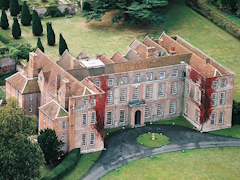
Glemham Hall is situated in Little Glemham, Woodbridge in Suffolk. Glemham Hall was built in 1560s by the De Glemham family. The Glemhams retained the estate until 1708-1709 when it was sold to Dudley North. Glemham Hall remained within the North family for more then 200 years. In 1923 it was purchased by the Cobbold family and became the home of Captain John Murray Cobbold who was killed during World War Two. When his wife died in 1987, the estate passed to her son, Patrick. Sadly, he died suddenly in 1994, where upon Major Philip Hope Cobbold inherited the estate and resided until his death in 2020. Philip's eldest son Thomas now lives at Glemham Hall with his wife and family.
The staircase has been known to have a ghostly presence, the bedrooms are known to be haunted, where wardrobe doors open by themselves! In the attic rooms sounds of children's laughter has been heard!
One not to be missed!
Private Hire Cost
£1550
Maximum people allowed for this price 24
Information on Glemham Hall
Deal Castle · Deal, Kent
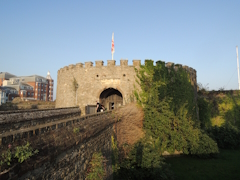
Deal Castle is an artillery fort constructed by Henry VIII in Deal, Kent, between 1539 and 1540. It protected against invasion from France. The Castle comprises of a keep with six inner and outer bastions, the moated stone castle and had sixty-six firing positions for artillery.
During the Second English Civil War of 1648–49, Deal was seized by pro-Royalist insurgents and was only retaken by Parliamentary forces after several months' of fighting.
Although it remained armed, Deal Castle was adapted by Sir John Norris and Lord Carrington during the 18th and 19th centuries to form a more suitable private house for the castle's captain, which was an honorary position.
In 1904, the War Office concluded that the castle no longer had any value either as a defensive site or as a barracks and it was opened to the public when the captain was not in residence. Early in the Second World War, the captain's quarters were destroyed by German bombing and the castle became a Battery Operating Post (one of the first-floor rooms in the keep became the Battery Office) for an artillery battery placed along the shore line. The castle was not brought back into use as a residence and was restored by the government during the 1950s to form a tourist attraction.
Private Hire Cost
£950
Maximum people allowed for this price 20
Information on Deal Castle
Shire Hall Courthouse · Dorchester, Dorset
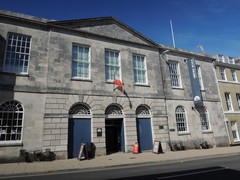
Shire Hall Historic Courthouse Museum in Dorchester, Dorset was Dorset's courthouse from 1797 until 1955. Through that time, it saw everything from the 1834 trial of the Tolpuddle Martyrs to the 1856 domestic abuse case that inspired Thomas Hardy to write 'Tess of the D'Urbervilles', to victims of mesmerism, child perpetrators and American GIs tried during the Second World War.
Discover the depths of the cold, dark cells, before ascending to the dock. Stand in the dock of the famous courtroom, where famous novelist and poet Thomas Hardy was a magistrate from 1884 until 1919.
See where the Tolpuddle Martyrs were held before being brought to trial, thereby sparking the Trade Union movement.
After ending its life as a court in 1955, Shire Hall was used as offices for West Dorset District Council (previously the Rural District Council).
Private Hire Cost
£950
Maximum people allowed for this price 24
Read previous customer Feedback/Testimonials
Information on Shire Hall Courthouse
Fort Burgoyne · Dover, Kent
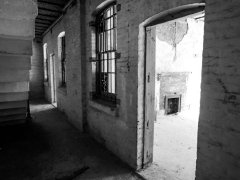
Fort Burgoyne in Dover, Kent was originally known as Castle Hill Fort. Work started in 1861 and it was complete in 1868 as one of the Palmerston forts surrounding the South of England.
It was built to a polygonal system with detached eastern and western redoubts with a surrounding ditch, flanked by three demi-caponniers and a double caponnier to the North. Two detached wing batteries to the East and West of the main fort were also constructed in spurs off the main ditch. The main fort comprised a large parade ground, to the North of which was a long row of casemates, which provided the barrack accommodation for soldiers and officers. Above the casemates, on the terreplein, were Haxo Casemates, which housed the guns.
This was to guard the high ground northeast of the strategic port of Dover, just north of Dover Castle.
The fort is named after the 19th century General John Fox Burgoyne.
After the First World War Fort Burgoyne was used as military depot or store for Connaught Barracks. Until recently the central part of the fort was still owned by the Ministry of Defence, forming part of the Connaught Barracks site.
There were two mysterious deaths in February 1887, two men died for no known reason.
Private Hire Cost
£850
Maximum people allowed for this price 30
Read previous customer Feedback/Testimonials
Information on Fort Burgoyne
Nothe Fort · Weymouth, Dorset
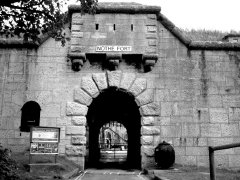
Nothe Fort in Weymouth, Dorset is situated on the shore beside the northern breakwater of the ex-military Portland Harbour, and at the mouth of civilian Weymouth Harbour. Nothe Fort was built in 1872 to protect Portland's harbour, which was then becoming an important Royal Navy base. The fort played an important role in World War II, when the harbour was used as base by the British and American Navy.
In 1956, the fort was abandoned, and in 1961 it was purchased by the local council. It is now a museum and tourist attraction, featuring models, World War II memorabilia as well as original cannons and guns and British and American WWII vehicles.
Nothe Fort has always had a legendary ghostly whistling gunner and many people claim to have heard his eerie whistling in the Fort's extensive underground passageways. Tales of this phantom have been talked about for decades around Weymouth and the Fort affectionately has a passageway dedicated to him. Who this 'shade' actually is, is at this time, unknown.
A survey carried out in 2007 by The National Lottery discovered that the Fort was voted one of the spookiest locations in the UK; in fact staff members sometimes refuse to visit certain areas by themselves.
Private Hire Cost
£850
Maximum people allowed for this price 20
Read previous customer Feedback/Testimonials
Information on Nothe Fort
Red Lion Hotel · Colchester, Essex
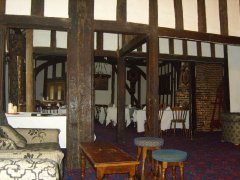
The Brook Red Lion Hotel in Colchester, Essex is a historical Grade I listed building dating back to 1465. Located in the busy town centre of Colchester, Britain's oldest recorded town, The Brook Red Lion Hotel in Colchester is one of the oldest inns in the area.
The Parliament Restaurant at the Red Lion Hotel was once the old Banqueting Hall, still showing its timbered beams.
There are three known ghosts - a small boy that can be seen in the Parliament restaurant occassionally and has appeared in a guest's photograph, a ghostly monk that hangs around in reception, but the most active is Alice Millar.
Alice was a chambermaid at the hotel and was killed by a lover.
Alice has regularly been heard whispering and even talking to staff. There are recent accounts of people's hair being pulled and a womans voice appearing on a video taken in one of the rooms, with no obvious cause.
The original rooms still have their original wattle and daub beams. They are also, obviously, the most haunted.
Private Hire Cost
£850
Maximum people allowed for this price 24
Read previous customer Feedback/Testimonials
Information on Red Lion Hotel
British Schools Museum · Hitchin, Hertfordshire
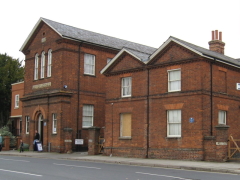
The British Schools Museum is in original Edwardian and Victorian school buildings in Hitchin in Hertfordshire, England. The museum complex is made up of school buildings housing infants, girls and boys schools with houses for Master and Mistress. It includes a monitorial schoolroom based on the educational theories of Joseph Lancaster for 300 boys, which opened in 1837, and a rare galleried classroom, dating from 1853.
The first school on the site was a schoolroom for 200 boys and 100 girls. It was founded in 1810 by local lawyer William Wilshere in a disused malthouse. This schoolroom was the first monitorial school for the sons of the poor in Hertfordshire. Teaching was based on Joseph Lancaster's methods of monitorial teaching. He developed a system in which large numbers of younger scholars could be taught by older scholars under the supervision of the master (for boys) or mistress (for girls). This method continued until the Revised Code of 1862 that brought in the Pupil Teacher method of teaching.
The school grew steadily and to such an extent that in 1837 a new schoolroom was built that could hold 300 boys. This was completed in 1838.
In 1857, it was decided by the School's Board of Trustees to completely rebuild the Girls' and Infants' School. The new building was completed in 1858 together with adjoining houses for the Master and Mistress.
It remained as a school until 1969.
Ghostly Activity includes full body apparitions, loud footsteps and crying voices.
Private Hire Cost
£800
Maximum people allowed for this price 20
Information on British Schools Museum
Fort Horsted · Chatham, Kent
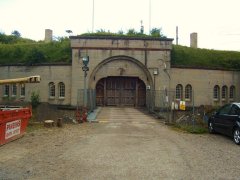
Fort Horsted was the largest of the five forts designed to defend Chatham's eastern and southern approaches. Many changes were made to the original design of Horsted since its inception in the 1860's. Most noticeably Fort Horsted does not have caponiers or other exposed external features clearly visible in earlier works such as the Drop Redoubt in Dover. This was due to the development of high explosive shells in the intervening period between the 1860's and the eventual construction some twenty years later. Fort Horsted was finished by 1889, but never received the full compliment of armament she was designed for. In 1902 Fort Horsted was mounted with seven machine guns. In the Second World War AA guns were mounted at the Fort.
Private Hire Cost
£800
Maximum people allowed for this price 24
Read previous customer Feedback/Testimonials
Information on Fort Horsted
Bilsington Priory · Ashford, Kent
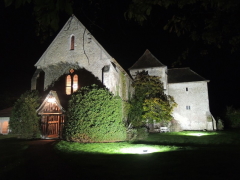
St Augustine's Priory, Bilsington, Kent was founded by John Mansel in June 1253 with the consent of Henry III and the Archbishop of Canterbury professing the rule of St Augustine.
The foundation charter was confirmed by a charter of Henry III, dated 12 June, 1253, which was confirmed afterwards by Henry VI in 1444 and Edward IV in 1466.
St Augustine's Priory was surrendered to the crown in 1535 and it was abandoned at Henry VIII's dissolution of the monasteries in 1538.
During the 1820s it was a base for smuggling gangs namely the Ransley Gang and The Aldington Gang. The Priory was restored 1906 by J.T. Micklethwaite, Architect
During the Second World War troops were billeted at St Augustine's Priory and at some point it was also an infirmary.
St Augustine's Priory has had a long and varied history and during our site visit we came across two Canadian Soldiers from the Second World War and a lady in Victorian dress lazing near to the pond.
Private Hire Cost
£750
Maximum people allowed for this price 24
Read previous customer Feedback/Testimonials
Information on Bilsington Priory
Whitstable Castle · Whitstable, Kent
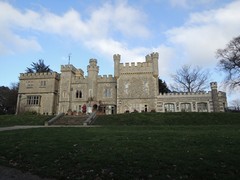
Whitstable Castle, Whitstable, Kent was built from copperas works in 1790 and this formed the Octagonal Tower. The black tar of the works can still be seen on the walls. The Pearson’s home was known as The Manor House and little is known about its layout except that in 1798 the chimney to the tower was taken down and a staircase put in its place.
The family spent every summer at the house, from their Greenwich based home. Charles Pearson died in 1828. His son Charles Pearson Junior, born in 1786, inherited the estate and carried on using the house as a summer residence. The Tower fell into neglect and he sold it to his cousin by marriage Wynn Ellis.
Wynn Ellis had the most significant impact and made the greatest contribution towards shaping the building and its grounds. In 1897 Tankerton Castle, as it was now known, was sold to Thomas Adams. He added a billiard room to the North of the original tower. This provided a good room with feature fireplace on the ground floor with servants’ quarters upstairs but obstructed the fine sea views of Whitstable Bay. Later this became the Council Chamber.
In 1921 the Castle passed into the hands of Mr Albert Mallandain. A paper manufacturer, he and his wife used it as a summer residence. Changes were made in the building, with a fine new staircase and extensive additional oak panelling to match original designs. The Whitstable Urban District Council, despite some some opposition, bought the Castle for the town in 1935.
Following the local government re-organisation in 1972, the Castle remained empty until 1975 when at the instigation of The Whitstable Society the "Castle Centre Association" was created with the aim of using The Castle for the benefit of the people of Whitstable. In 2004 a new committee with its first Castle Co-ordinator began a complete interior upgrade and Weddings and Civil Ceremonies could commence. This brought in much needed income to regenerate the Castle and enable it to return to its original role as a venue for family celebrations, major local events and community activities. A heritage Lottery Grant enabled a new Trust to be formed in 2008 to take over the running of the Castle and Gardens.
Private Hire Cost
£725
Maximum people allowed for this price 20
Information on Whitstable Castle
Beacon Hill Fort · Harwich, Essex
Beacon Hill Fort in Harwich, Essex was originally three blockhouses, constructed during the reign of Henry VIII, following his visit to the town in 1543.
The site was chosen for Harwich Barracks. These were built in 1803. They subsequently housed most of the Harwich army and militia camp during almost the whole French Revolutionary and Napoleonic Wars era, and a naval signal station.
In 1889 work began on a totally new fort, which was completed in 1892. The fort saw use in World War One, and was re-adapted in World War Two. The Beacon Hill site also from time to time housed anti-aircraft guns and torpedo tubes.
The fort was finally decommissioned in 1956.
Uncertainty still surrounds the death of Gregory Chung whose burnt and decomposing body was found at the Beacon Hill fort at Harwich in 2000. A murder inquiry was launched but the inquest heard it was probable Mr Chung, 23, set fire to himself.
Private Hire Cost
£700
Maximum people allowed for this price 20
Read previous customer Feedback/Testimonials
Information on Beacon Hill Fort
Harwich Redoubt Fort · Harwich, Essex
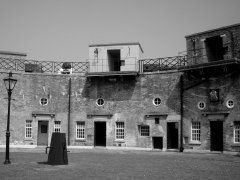
Harwich Redoubt Fort in Harwich, Essex was constructed between 1808 and 1810 to protect the port of Harwich against the threat of Napoleonic invasion. The fort was constructed on a hill, which allowed views in all directions.
French prisoners of war were made to help construct the fort. The fort has a central parade ground. It was originally armed with ten 24 pounder cannons. In 1861 a 68 pounder cannon was added to the fort's weapon range.
Later in 1903 three 12 pounder QF guns were added to the fort. Despite the ongoing modernisation no shot was fired in force. In the 1920s the redoubt was falling into disrepair. The fort was briefly used during the Second World War to house British troops awaiting trial. Restoration started in 1969 and still continues today.
Ghostly Activity
Witnesses have reportedly seen apparitions through the windows and heard unexplained footsteps. Many visitors to the fort have also reported being touched by unseen hands in the lower casements. There have also been many other mysterious noises and apparitions seen by visitors.
The fort is well known for the apparition of a headless soldier. In 1972 a soldier was decapitated by a cable attached to a 12 ton cannon which broke under the strain. It is rumoured that this soldier now roams the fort.
Private Hire Cost
£700
Maximum people allowed for this price 24
Read previous customer Feedback/Testimonials
Information on Harwich Redoubt Fort
Slough Fort · Allhallows, Kent
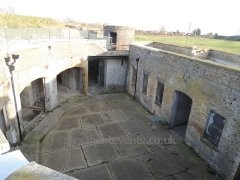
Slough Fort, Allhallows, Kent is a small artillery fort that was built in the north of the Hoo Peninsula in Kent. Constructed in 1867, the D-shaped fort was intended to guard a vulnerable stretch of the River Thames against possible enemy landings during a period of tension with France. Its seven casemates initially accommodated rifled breech loading guns, which were replaced by the turn of the century by more powerful breech-loaders on disappearing carriages, mounted in concrete wing batteries on either side of the fort. It was likely one of the smallest of the forts constructed as a result of the 1860s invasion scare.
All of the guns were removed by 1912, though the fort continued in use during the First World War as a command post. It was decommissioned in 1920 and sold off in 1929 and converted into a small zoo. Before the Second World War; it was used as an observation post from 1938, became part of the local anti-invasion system in 1939-40 and was used as part of the air defence network against V-1 flying bombs in 1944. There was partial restoration in 2012-13 that uncovered previously buried features of the fort.
Ghostly Activity
Whilst on our site visit a strange presence was felt in the Brig (cells) area of the fort, as well as previous visitors hearing a girl laughing in the right wing battery part of the Fort.
Private Hire Cost
£600
Maximum people allowed for this price 24
Read previous customer Feedback/Testimonials
Information on Slough Fort